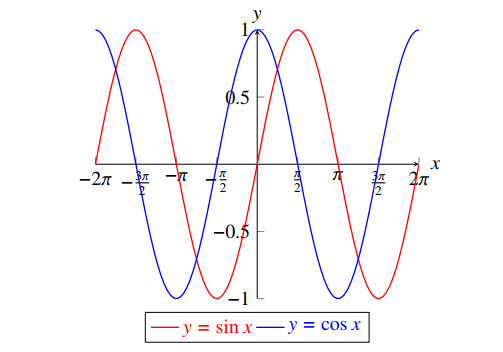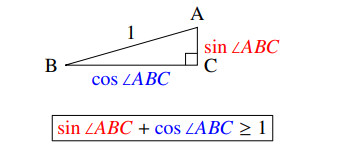1.
Description of Theorem 1.1
As one of the fundamentals of algebraic-complex geometry, the analytic Hilbert's Nullstellensatz (either theorem of zeros or zero-locus theorem) [1] on the finite complex plane C asserts that for finitely many analytic polynomials {pj}nj=1 without common zeros in C,
This celebrated principle has been improved and extended for more than a century; see e.g., Hermann [2], Masser-Wüstholz [3], Brownawell [4], Kollár [5], and Kwon-Neryanun-Trent [6] whose Lemma 1.4 especially indicates that an entire function Y is a polynomial on C if and only if lim|z|→∞|z|−m|Y(z)|=0 for some positive integer m.
Meanwhile, in complex trigonometry, the Pythagorean Identity on C states that
and sinz & cosz have no common zero as graphically shown below
Although the entire functions sinz & cosz are not analytic polynomials, they can be appropriately approximated by analytic polynomials and satisfy:
where this last inequality is geometric due to the basic fact that the sum of the lengths of the adjacent & opposite sides BC & CA is not less than the length of the hypotenuse AB in the right triangle △ABC drawn below
The previous two-fold observation actually inspires us to extend the analytic Hilbert's Nullstellensatz to some entire function spaces.
For α>0, let F2α be the Fock-Hilbert space of all L2(λα)-integrable entire functions (or analytic functions on C) with the inner product
where
Moreover, for a nonnegative integer m, let F2α,m be the quadratic m-order Fock-Sobolev space of all entire functions obeying
Evidently,
see also Zhu's book [7] for more information.
Since all analytic polynomials are dense in F2α,m, as a somewhat unexpected variant of Eqs (1) and (2) we discover the following corona-type principle.
Theorem 1.1. Let
If g is an entire function with
then
Especially, if
then
2.
Demonstration of Theorem 1.1
For α∈(0,∞), let
Then some elementary calculations derive the following four formulae:
Consequently,
Moreover, a modification of Cho-Zhu's statement on [8, p. 2496] gives the following pointwise estimation
Lemma 2.1. For
let ϕ:C→R & g:C→C be C2-smooth with
(i) Weighted (Lp,ˉ∂)-estimation - not only for a given function f on C there exists a weak solution u∈Lp(e−2ϕ) to ˉ∂u=f in the sense of
if and only if
but also Eq (4) holds for all f∈Lp((Δ(2ϕ)e2ϕ)−1) if and only if
(ii) Uniqueness up to entire Lp(e−2ϕ)-functions - arbitrary two solutions in (i) differ by a function h∈Ap(e−2ϕ) with
(iii) Weighted (Lp,ˉ∂)-Poincaré inequality - if u∈C1 satisfies (i) above and the Lp(e−2ϕ)-minimality below
then
and consequently, if u∈C1 enjoys the case p=2 of (i) and the L2(e−2ϕ)-orthogonality
then Eq (7) holds for p=2.
(iv) Weighted (L2,ˉ∂)-estimation is always available.
(v) Uniqueness - if
then the solution in (iv) is unique.
Proof. (i) This part is motivated by Berndtsson's [9, Theorems 2–3]. But, the argument comes from an adjustment of the case p=2 presented in Berndtsson's [10, Proposition 1.1].
Suppose that for a given function f on C there exists a weak solution u∈Lp(e−2ϕ) to ˉ∂u=f in the sense of Eq (3). Then the Hölder inequality derives
Hence Eq (4) holds for the previous function f. Conversely, if Eq (4) is valid for a given function f on C, then
is a subspace of Lp′(e−2ϕ), and hence the given function f induces the following bounded antilinear functional on Sϕ:
This, along with the Hahn-Banach extension theorem, ensures an extension of Lf from Sϕ to Lp′(e−2ϕ). Consequently, the Riesz-type representation theorem for the dual of Lp′(e−2ϕ) produces a function
such that
Upon taking G=ˉ∂∗2ϕg, we find that the last function u∈Lp(e−2ϕ) is a weak solution to ˉ∂u=f in the sense of Eq (3).
Moreover, if Eq (4) holds for all f∈Lp((Δ(2ϕ)e2ϕ)−1), then an application of the duality
under the pairing
derives Eq (5). Evidently, if Eq (5) holds, then ⟨f,g⟩2ϕ deduces that Eq (4) is valid for all f∈Lp((Δ(2ϕ)e2ϕ)−1).
As an aside of the preceding demonstration, we achieve that for any f∈Lp((Δ(2ϕ)e2ϕ)−1) there exists a weak solution u∈Lp(e−2ϕ) of ˉ∂u=f with
if and only if Eq (5) holds.
(ii) This follows from the fact that ˉ∂u=0 if and only if u is analytic.
(iii) This comes from a modification of the argument for Berndtsson's [10, Corollary 1.4]. Indeed, without loss of generality, we may assume
Now, the verification of (i) ensures that
has a weak solution v enjoying the inequality
Note that (ii) produces a function h†∈Ap(e−2ϕ) such that v=u+h†. So Eqs (6) & (10) imply
as desired in Eq (7).
Especially, if Eq (8) is valid, then a combination of
and the closedness of A2(e−2ϕ) in L2(e−2ϕ) yields a function h‡∈A2(e−2ϕ) such that
Upon noticing ˉ∂(v+h‡−u)=0, we obtain
As a consequence, u is the L2(e−2ϕ)-minimal solution to ˉ∂v=ˉ∂u. Thus, the weighted (L2,ˉ∂)-Poincaré inequality follows from the first inequality of Eq (11) and the case p=2 of Eq (10).
Here it is appropriate to mention that as shown in [10, Theorem 3.3] the case p=2 of Eq (10) can be used to establish the following Brunn-Minkowski-type concavity: if D is a convex open subset of the (n+1)-dimesnional Euclidean space Rn×(−∞,∞) and Dt={x:(x,t)∈D} then the Lebesgue measure Mn(Dt) satisfies ∂2tlogMn(Dt)≤0 - i.e., - the function t↦logMn(Dt) is concave - in particular - so is t↦logA(Dt)=logM2(Dt).
(iv) This is a minor variant of [11, Theorem 1.1] - the well-known Hörmander L2-estimate for the ˉ∂-equation presented in [12]. In fact, given f∈L2((e2ϕΔ(2ϕ))−1) the basic identity (cf. [10, Proposition 1.2])
ensures the second iff-condition of (i) with p=2
thereby reaching the existence of a weak solution u to ˉ∂u=f with
(v) Such a uniqueness is newly induced by Eq (1). Yet, its proof is similar to the argument for Hedenmalm's curvature-orientated uniqueness of the ˉ∂-equation in [11, Theorem 1.4]. As a matter of fact, if u1&u2 are two solutions in (iv), then u1−u2 is an entire function on C due to (ii), and hence log|u1−u2| is subharmonic on C. This, plus Eq (2), deduces
and so that
is subharmonic on C. Now, for any
a combination of Eq (9), the mean-value-inequality for the subharmonic function |u1−u2|eϕ and the Cauchy-Schwarz inequality derives
Letting r→∞ in the last estimation gives
Since z0 is arbitrary, the last equality ensures u1=u2 on C.
Argument for Theorem 1.1. Clearly, if g≡1 in (3)–(4), then (5)⟹(6) follows from Eq (3)⟹(4) which is verified as below.
Suppose that (3) is valid. Let
If bj,k is a function solving pointwisely the ˉ∂-equation
then each
is an entire function enjoying
and hence the equation in (4) is met.
Thanks to the smoothness of f1,...,fn,g, Lemma 2.1(iv) with
produces a function bj,k such that (12) holds pointwisely with
In order to achieve gj∈F22mα,1 in (4), in the sequel we employ (12)–(13) to prove
⊳ It is easy to get
In the above and below, X≲Y stands for X≤cY for a positive constant c.
For the case m=1, we utilize Eqs (1) & (3) to derive
For the case m>1, we utilize Eq (1) - the Hölder inequality - Eq (3) to derive
In summary, we always have
Now, a straightforward computation gives
As evaluated in [13,14], we have
thereby producing
Clearly, we get
whence verifying the first inequality of (15).
⊳ According to Lemma 2.1(i), there exists bj,k classically resolving (12) with (14), and consequently, a combination of Eqs (1) & (17) yields
Since the comparable constants in (18) are independent of {j,k}, the formula (13), along with (16) & (18), validates the second inequality of (15).
Acknowledgements
XL was supported by NNSF of China (#12171150; #11771139) & NSF of Zhejiang Province (LY20A010008); JX was supported by NSERC of Canada (#202979) & MUN's SBM-Fund (#214311); CY was supported by NNSF of China (#11501415).
Conflict of interest
The authors declare there is no conflict of interest.














 DownLoad:
DownLoad: